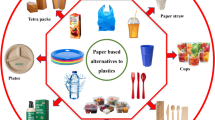Abstract
The paper investigates the effect of PF resin modification on the possibility of shortening the time or reducing the temperature when pressing particleboards glued with phenolic resin modified with amide polymers, and on the physical and mechanical properties of the boards. The applied activators of PF resin were as follows: polycaprolactam and its N-hydroxymethylene derivative, polyacrylamide and acrylamide. The scope of the research included studies regarding the influence of these modifiers upon properties of fluid PF resin, the production of particleboards at various pressing conditions and the determination of their physical and mechanical properties. The obtained results show that the modification of PF resin with amide polymers makes it possible to increase the reactivity of the resin and to produce, in a shorter time or at a lower temperature, particleboards with comparable or better properties than those of the boards produced under industry-like conditions.
Zusammenfassung
Die vorliegende Studie untersucht den Einfluss einer Modifizierung von Phenolformaldehydharz (PF Harz) auf mögliche Presszeitverkürzung bzw. Presstemperatursenkung bei der Herstellung von Spanplatten, die mit Amidpolymeren modifiziertem PF Harz verleimt wurden, sowie den Einfluss einer solchen Modifizierung auf die physikalischen und mechanischen Eigenschaften dieser Platten. Als Aktivatoren des PF Harzes wurden Polyamid 6 (PA 6) und dessen N-Hydroxymethylenderivat, Polyacrylamid sowie Acrylamid eingesetzt. Geprüft wurde der Einfluss der genannten Modifikatoren auf die Eigenschaften des flüssigen PF Harzes, auf die Herstellung von Spanplatten unter verschiedenen Pressbedingungen sowie auf die physikalischen und mechanischen Eigenschaften dieser Platten. Aus den Prüfergebnissen geht hervor, dass die Modifizierung des PF Harzes mit Amidpolymeren eine Steigerung der Reaktionsfähigkeit von PF Harz ermöglicht. Ferner zeigte sich, dass bei verkürzter Presszeit bzw. gesenkter Presstemperatur Spanplatten hergestellt werden können, deren Eigenschaften vergleichbar oder sogar besser sind als die der unter annähernd industriellen Bedingungen hergestellen Platten.
Similar content being viewed by others
References
Carins T (1947) Polyamide-formaldehyde reaction and products. Pat US 2,430,860
Carins T (1948) Polyamides. Pat US 2,441,057
Carins T, Foster HD, Larchar AW (1949) Preparation and properties of N-methylol, N-alkoxymethyl and alkylthiomethyl polyamides. J Am Chem Soc 71:651–654
Carins T, Gray HW, Schneider AK (1949) The reaction of N-alkoxymethyl polyamides. J Am Chem Soc 71:655–658
Czarnecki R, Łecka J (2003) H2O2 as a modifier of phenol-formaldehyde resin used in the production of particleboards. J Appl Polym Sci 88:3084–3092
Higuchi M, Tohmura S, Sasaki I (1994) Accelerated curing of phenolic resin adhesives V: Catalytic actions of carbonates and formamide. J Jap Wood Res Soc 40:604–611
Narayanamurti D, George J, Anand AS (1961) Accelerated curing of phenol-formaldehyde resin adhesives for plywood. Part I. The use of inorganic accelerators. Paintindia Annual 4:145–146
Oldöerp K, Marutzky R (1998) Untersuchungen an Spanplatten mit harnstoffmodifizierten PF-Harzen. Holz Roh- Werkst 56:75–76
Osman Z, Pizzi A, Kantner W, Triboulot MC (2005) PUF panel adhesives doped with additional urea and reinforced by isocyanates. Holz Roh- Werkst 63:53–56
Park BD, Riedl E, Hsu J, Shields J (2001) Application of cure-accelerated phenol-formaldehyde (PF) adhesives for three layer medium density fiberboard (MDF) manufacture. Wood Sci Technol 35:311–323
Pizzi A, Stephanou A (1993) Rapid-curing lignin-based exterior wood adhesives. Part II. Esters acceleration mechanism and application to panel products. Holzforschung 47:501–506
Pizzi A, Stephanou A (1994) Completion of alkaline cure acceleration of phenol-formaldehyde resin: acceleration by organic anhydrides. J Appl Polym Sci 51:1351–1352
Pizzi A, Stephanou A (1994) Phenol-formaldehyde wood adhesives under very alkaline conditions. Part I. Behavior and proposed mechanism. Holzforschung 48:35–40
Pizzi A, Stephanou A (1994) Phenol-formaldehyde wood adhesives under very alkaline conditions. Part II. Esters curing acceleration, its mechanism and applied results. Holzforschung 48:150–156
Pizzi A, Walton T (1992) Non-emulsifiable, water-based, mixed diisocyanate adhesive systems for exterior plywood. Part I. Novel reaction mechanisms and their chemical evidence. Holzforschung 46:541–547
Proszyk S, Pajdosz K (1989) Investigation concerning the reactivity of thermosetting phenolic resin in the presence of selected metallic oxides. IX Sympozium. Pokroky vo vyrobe a pouziti lepidiel v drevopremysle. Zbornik referatov. Stražske, Słowacja, pp 39–51
Tłokowski S (1972) Modyfikacja żywicy fenolowo-formaldehydowych poliamidem M. Polimery Tworzywa Wielkoczasteczkowe 2:81–84
Tohmura SI, Higuchi M, Sakata I (1993) Acceleration of the cure of phenolic resin adhesives. Part III. Kinetics of curing reaction (2). J Jap Wood Res Soc 39:650–657
Tohmura S, Higuchi M (1995) Acceleration of the cure of phenolic resin adhesives VI. Cure accelerating action of propylene carbonate. J Jap Wood Res Soc 41:1109–1114
Wang S, Pizzi A (1997) Waste nylon fibre hardeners for improved UF wood adhesives water resistance. Holz Roh- Werkst 55:91–95
Zhao C, Pizzi A, Garnier S (1999) Fast advancement and hardening acceleration of low-condensation alkaline PF resins by esters and copolymerized urea. J Appl Polym Sci 74:359–378
EN 120: 1992 Wood-based panels – Determination of formaldehyde content – Extraction method called the perforator method
EN 310: 1993 Wood-based panels — Determination of modulus of elasticity in bending and of bending strength
EN 317: 1993 Particleboards and fibreboards – Determination of swelling in thickness after immersion in water
EN 319:1993 Particleboards and fibreboards – Determination of tensile strength perpendicular to the plane of the board
EN 1087-1:1993 Particleboards – Determination of moisture resistance – Part 1: Boil Test
Author information
Authors and Affiliations
Corresponding author
Rights and permissions
About this article
Cite this article
Dukarska, D., Łecka, J. Optimization of the process of pressing particleboards by means of modifying phenol-formaldehyde resin with amide polymers. Holz Roh Werkst 64, 403–409 (2006). https://doi.org/10.1007/s00107-005-0093-5
Published:
Issue Date:
DOI: https://doi.org/10.1007/s00107-005-0093-5




